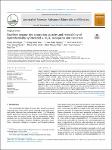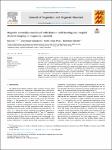Browsing by Author Das, Raja
Showing results [1 - 3] / 3
α-Fe2O3 and Fe3O4 nanoplates and nanorices were synthesized by hydrothermal reaction and used for organic pollutant adsorption and removal studies. The effect of size and morphology of α-Fe2O3 and Fe3O4 nanoplates and nanorices on the dye adsorption efficiency were investigated systematically. The adsorption studies showed a good selectivity and high adsorption capacity (~93%) of the α-Fe2O3 nanoplates towards congo red (C.R.) dye, due to the formation of hydrogen bonding between amine group (─ NH2) of C.R. and surface carboxylate group (─ COOH), and adsorbed ─ OH groups of α-Fe2O3 nanoplates. The α-Fe2O3 nanoplates also showed excellent recyclability with negligible loss of the adsor... |
Magnetite has fascinated researchers for decades, due to its wide range of applications from spintronics to biomedicine. Despite a large body of works aimed at its magnetic properties, no consensus has been reached on the physical origin of the low temperature magnetic anomalies observed in magnetite. Although, a lot of work has been done in studying magnetite nanoparticles, but studies on the low temperature anomalies in those nanoparticles still remains unresearched. We report on the observation of the low temperature magnetic anomalies in highly crystalline, stoichiometric Fe3O4 nanorods and relate them to the coupled electron hopping relaxation process and domain wall motion. Both... |
The use of magnetic nanoparticles in the treatment of cancer using alternating current hyperthermia therapy has shown the potential to replace or supplement conventional cancer treatments, radiotherapy and chemotherapy, which have severe side effects. Though the nearly spherical sub-10 nm iron oxide nanoparticles have their approval from the US Food and Drug Administration, their low heating efficiency and removal from the body after hyperthermia treatment raises serious concerns. The majority of magnetic hyperthermia research is working to create nanomaterials with improved heating efficiency and long blood circulation time. Here, we have demonstrated a simple strategy to enhance the... |



